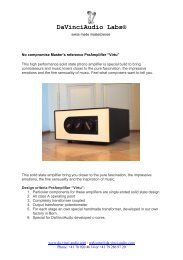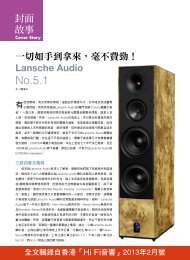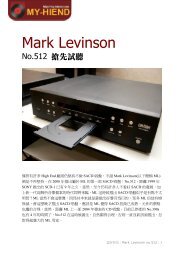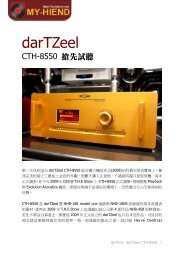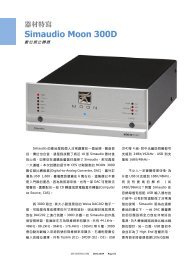Linn Klimax.indd - My Hiend
Linn Klimax.indd - My Hiend
Linn Klimax.indd - My Hiend
You also want an ePaper? Increase the reach of your titles
YUMPU automatically turns print PDFs into web optimized ePapers that Google loves.
Ethernet with the supplied <strong>Linn</strong> ‘GUI’<br />
and Twonky media server software. In<br />
my case, I set the <strong>Linn</strong> up via a <strong>Linn</strong>supplied<br />
Toshiba PC, and plugged its<br />
balanced outputs into my reference<br />
MF Audio Silver Passive Preamplifier,<br />
driving a World Audio K5881 tube<br />
amplifier and Yamaha NS1000M<br />
loudspeakers.<br />
The results were deeply<br />
impressive and, spookily, I couldn’t<br />
stop thinking about my year spent<br />
with a Sondek CD12 some time back.<br />
Although the <strong>Klimax</strong> DS and CD12<br />
share little (beautiful aluminium billet<br />
case excepted), <strong>Linn</strong>’s high end digital<br />
products are so meticulously voiced<br />
that – despite the very different<br />
chipsets inside – the two have the<br />
same silky but ultra high resolution<br />
sound that gets into the groove with<br />
the best of them.<br />
With all of my own reference<br />
recordings, committed to the <strong>Linn</strong><br />
PC as .wav files (i.e. uncompressed<br />
16/44 LPCM), I heard a consistently<br />
smooth and well finessed<br />
performance, with an extremely<br />
neutral yet vivid tonality. Bass was<br />
strong and expressive, but in no way<br />
warm or overblown. Midband was<br />
tremendously wide and deep, bristling<br />
with detail and yet never veering<br />
towards stridency, whilst treble<br />
was fine and subtle. The key to the<br />
performance that simply makes me<br />
wish I was playing my vinyl version<br />
of this Blue Note classic, I heard a<br />
smooth, natural, spacious rendition<br />
of the disc, with that lovely ebbing<br />
and flowing rhythm that ‘I Have a<br />
Dream’ sets up. Once again, the<br />
texturality of the instruments was<br />
beautifully carried, with ‘shouty’ brass<br />
instruments such as the trumpet and<br />
fluegelhorn losing none of their feel<br />
but – unusually for digital – gaining<br />
no chromium plating either. Speaking<br />
of metal, the heavily compressed,<br />
noise-addled thrash of Ministry’s<br />
‘Corrosion’ was massively powerful<br />
yet surprisingly listenable – testament<br />
to the <strong>Klimax</strong>’s characteristic ‘iron<br />
fist in a velvet glove’. DP<br />
CONCLUSION<br />
While many British hi-fi manufacturers<br />
have been unstinting in their<br />
condemnation of ‘computer audio’,<br />
<strong>Linn</strong> were an early adopter (the<br />
original Kivor is several years old<br />
already), and have once again done<br />
themselves proud with the <strong>Klimax</strong><br />
DS. Obviously, it’s not a product for<br />
everyone, but to those with large<br />
amounts of digital music stored<br />
on their computers and/or hard<br />
drives (and this number is bound to<br />
increase exponentially over the next<br />
few years as the iPod generation<br />
grow up into real hi-fi), it’s a<br />
landmark product.<br />
Essentially, the first truly high end,<br />
high resolution network music player,<br />
it boasts the company’s trademark<br />
superlative design and build, plus<br />
sonics which are the equal of pretty<br />
much any optical disc player on the<br />
market.<br />
A beautifully engineered, flexible<br />
and superb sounding music playing<br />
device, its biggest problem is simply<br />
the fact that most people won’t<br />
yet understand its reason for being.<br />
Although obvious to ‘early adopting’<br />
digital music devotees, mainstream<br />
audiophiles may struggle to see how<br />
it works and even why it exists in the<br />
first place. Then of course, there's the<br />
price, which is prohibitively expensive<br />
for most people - here's hoping the<br />
technology will 'trickle down' into<br />
more affordable fare.<br />
As the whole world slowly<br />
moves away from ‘physical media’,<br />
there will be more and more<br />
products like <strong>Linn</strong>'s <strong>Klimax</strong> DS, but<br />
this one is special and will continue<br />
to be years later. Whether it's too far<br />
ahead of its time right now, remains<br />
to be seen. DP<br />
[turn to p33 for MEASURED<br />
PERFORMANCE]<br />
REVIEW<br />
HI-FI WORLD<br />
VERDICT<br />
Impeccably engineered, built and voiced,<br />
this is a landmark high end digital<br />
product, but whether it’s too far ahead<br />
of its time is too soon to say.<br />
LINN KLIMAX DS £9,600<br />
<strong>Linn</strong> Products Ltd.<br />
+44 (0)500 888 909<br />
www.linn.co.uk<br />
)<br />
FOR<br />
- state of the art sonics<br />
- superlative build and finish<br />
- concept, flexibility<br />
AGAINST<br />
- price<br />
<strong>Klimax</strong> DS was the way it conveyed<br />
vast amounts of detail and strung it<br />
all together as a coherent and very<br />
emotive musical performance.<br />
With 4hero’s superbly recorded<br />
new album, ‘Play With The Changes’,<br />
I got a tremendously neutral vocal<br />
sound on ‘Give In’. The <strong>Klimax</strong> DS<br />
captured the singer’s voice with<br />
an eerie realism, and intimated his<br />
every subtle inflection. Behind this<br />
was a sumptuous keyboard backing<br />
which the <strong>Linn</strong> again carried with<br />
aplomb, proffering an extremely wide<br />
soundstage that hung back more<br />
than I’d heard with CD to date. The<br />
<strong>Klimax</strong> provided razor-sharp timing,<br />
as evinced by the giddying attack of<br />
hi-hat cymbals.<br />
Herbie Hancock’s ‘The Prisoner’<br />
was also unrecognisably ‘analogue’<br />
sounding, the <strong>Klimax</strong> DS giving no<br />
clues that it was [a] digital and [b]<br />
using a Toshiba PC’s hard drive as a<br />
source! Instead of the usual stilted<br />
SECOND THOUGHTS<br />
I installed the new <strong>Klimax</strong> DS as the front end of my reference system. <strong>Linn</strong> supplied me with a<br />
Dell PC (so I didn’t need to set up my own), which came with a number of high resolution tracks<br />
pre-loaded (after all, the unit will sing all the way to 192kHz sampling) but I also installed some<br />
additional tracks including some high quality Chinese recordings which I had discovered on a<br />
recent trip to Singapore. (Believe me, some of these CDs put to shame many of the factory-studio<br />
discs we see in the West - the recordings are mastered in DSD, employ high-quality electronics and<br />
microphones and use simple techniques with little or no compression). Replay equipment included<br />
Audio Physic Tempo loudspeakers with two muRata supertweeters atop each one, LFD power<br />
amplification and a digitally controlled analogue gain stage. Normally my system incorporates an<br />
LFD DAC3 preceded by a dCS sampling-rate converter to filter source jitter. Audition commenced in<br />
a darkened room to reduce cross-sense contamination, first by sampling the hi-res <strong>Linn</strong> tracks and<br />
then moving to familiar CD recordings.<br />
It was obvious that the <strong>Klimax</strong> DS occupied rarefied and esoteric sonic territory, as I don’t<br />
think I’ve ever heard better from a digital source. The results were magical, and it was immediately<br />
evident that the performance had risen significantly above my in-house reference converter, itself<br />
capable of superb clarity. The stereo soundstage proved truly capacious, giving a wonderful sense<br />
of envelopment, and transients were fast and totally devoid of grain, edge or smear. Vocals had<br />
stunning presence and immediacy, and overall the sound texture was delicate, natural and beautifully<br />
reproduced. As the music faded at the end of a track, it seemed to reach out and touch infinity,<br />
such was the clarity and low level signal integrity of this machine. Although the supplied 24/192<br />
recordings proved wonderfully realistic, fast and articulate with a lush, shimmering metallic quality<br />
to percussion, what really surprised me was how well the <strong>Klimax</strong> DS did with plain old 16/44.1.<br />
The sound was a revelation, but I just wish it hadn’t taken over thirty years to get here – all those<br />
wasted hours! MH<br />
www.hi-fiworld.co.uk OCTOBER 2007 HI-FI WORLD



